|
April 13, 2013 Moon Fun Chin turned 100!! Click here for some pictures of his birthday celebration at the Flower Lounge in Millbrae, California. And then it was Moon's birthday - again -- 106 --- WOW!!! Uncle, you look GREAT!!! Thank you so much for being you! 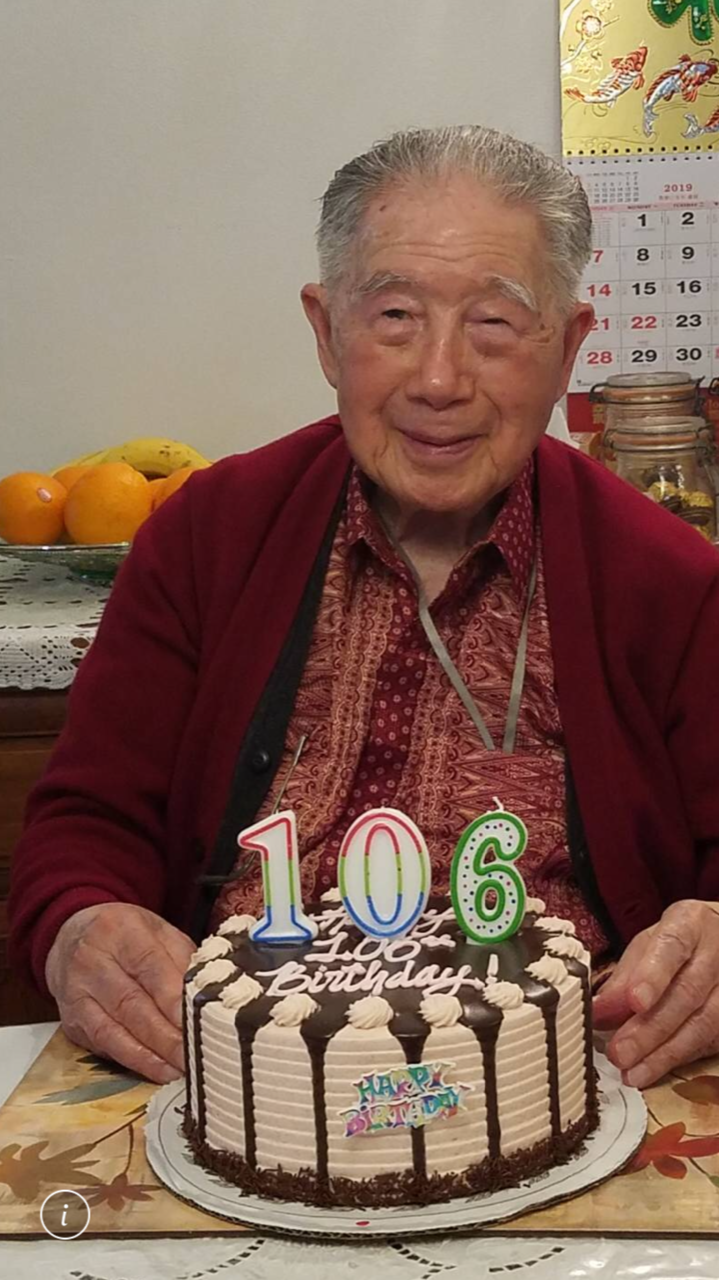 Then on April 13, 2020 Uncle Moon turned 107. WOW!!! 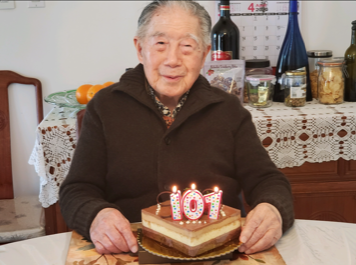
Then on April 13, 2021 Uncle Moon turned 108. Absoulety AMAZING! 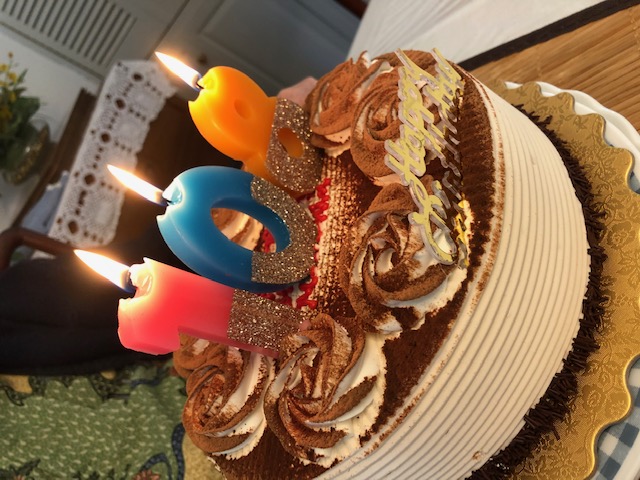 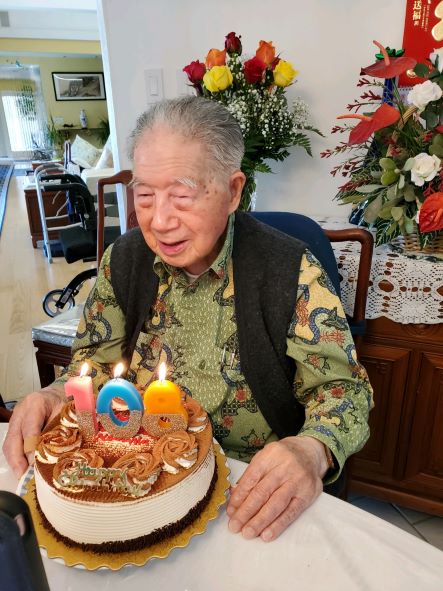
From Gene Banning's list of 8/31/00" "1936 flew as Capt on Commodore, evac Hankow, 1938; left CNAC in 1946 to operate own line." 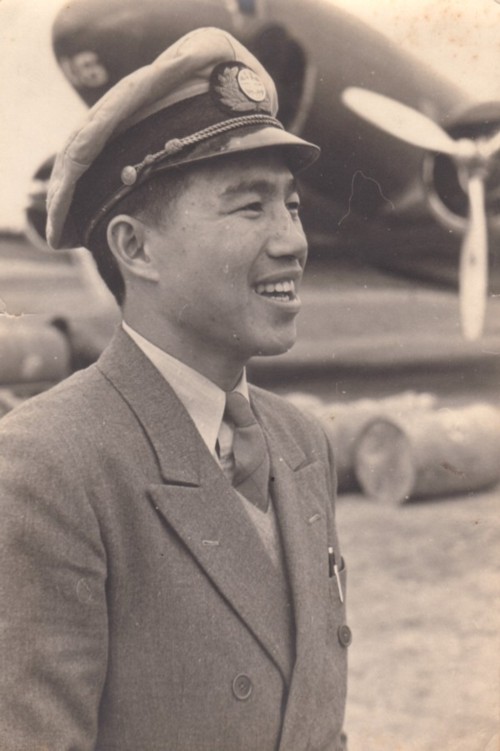 Moon F. Chin about 1935 April 30, 2001 From Jim Dalby "Tom A couple of weeks ago Monumental Productions interviewed Moon for about 6 hours and I was absolutely fascinated by his history with CNAC. I will try and give you a short run-down on what he said. Moon was born in China a little ways west of Macao in 1913. When he was very young his father, who was a Chinese Citizen of the USA came and picked him up and took him to Seattle, WA. After a few years in the Seattle area they moved to Baltimore, MD where he graduated from High School. After High School he enrolled in the Curtiss-Wright flying school and got his Commercial License. His Uncle, who lived in China, was a friend of Langhorne Bond and had heard that CNAC was going to expand their operations. In 1933 Moon went to China and talked to Bond. Bond hired him as a co-pilot on Stinsons based in Chentu where he flew between Chengtu and Chungking. In Chungking he picked up the passengers who had flown up the Yangtze river in Loenings and were continuing on to Chengtu. In time he flew as co-pilot on the Loenings then flew as Captain on Stinsons, Loenings, Consolidated Commodores, Douglas Dolphins, Sikorsky S-38s, DC-2s and DC-3s until about 1946 when he went to work for CATC (I believe). During the war he was #4 on the senority list and flew mostly passenger flights. In April 1942 he flew James H. Doolittle from Kunming to Myitkyina. After loading about 80 people in the plane they flew non-stop to Calcutta. Later he flew many US Navy personnel back and forth to the Gobi Desert where the Navy had established a weather station. It was one of these Navy Officers who was killed in Pop Kessler's plane crash. Very interesting. Jim" 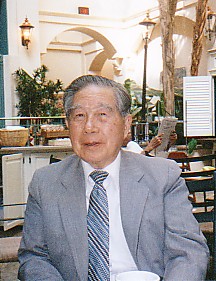
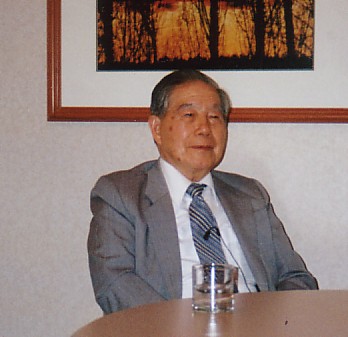 Moon Fun Chin 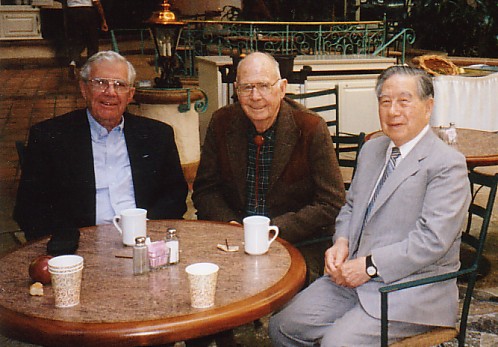 (left to right) Bill Maher, Jim Dalby and Moon Chin The above three photos were taken March 25, 2001 Embassy Suites, Burlingame, near SFO (Photos Courtesy of Jim Dalby) September 10, 2001 From Teh T. Chen "We knew Moon Fun Chin from 1934, before he marrried Elsie. May 22, 2004 I received the following e-mail from an old friend of Moon Chin's. With the writer's permission, here is that story. I happened upon your site looking for info on Moon Chin, a name that became etched in our family lore in 1954. On March 19, 1954 (my 5th birthday), my father, Maj. Albert H. Grinsted, Jr., bailed out of a C-119 into the South China Sea. This aircraft was ultimately heading to Dien Ben Phu to drop pallets of supplies to the beseiged French. He and the crew spent 12 hours in one man dinghies in 15 foot seas. Moon Chin flew the aircraft that accomplished my father's rescue (a PBY, I think). Moon Chin is a hero within our family. Our family exchanged Christmas cards with him for many years and at some point in Dad's Air Force transfers we lost contact. Dad passed away in February of this year (burial at Arlington, full military honors). According to the web site, it would seem that Moon Chin may be residing in the U.S. I saw the photos in SF with Jim Dalby & Bill Maher -- marvelous! Perhaps you could forward this inquiry to those gentlemen or even to Moon Chin himself, as I would like to re-establish that contact and to be able to again express my gratitude for his heroic efforts in getting a daddy home to a 5 year old all those many years ago. There is; "small world, remarkable coincidence"; here is a story associated with this relationship. My first husband's father, Lester Legler and his wife, Nellie, apparently were friends of Moon Chin's when they were residents of Taipei during the 50's and 60's. They may have been friends through the Masonic Lodge, I'm not sure. So it turns out that both of my oldest daughter's grandfathers had a relationship with Moon Chin. What are the odds?? This daughter followed in the family aviation tradition, United States Air Force Academy class of 1991, and was a C-130 aircraft commander during her 10 years of Air Force service. (See additional e-mail below from Gayle.) My youngest daughter is currently visiting in Taipei and if Moon Chin still resides there and you could put me in contact by forwarding this email, we would make every effort for her to convey of family's appreciation for hishaving saved our father's life. Our contact info: Col. (USAF Ret.) & Mrs. Richard E. Lawyer 208 Hawk Lane Palmdale, CA 93551 661-272-1557 Best email address: gayliegl@aol.com Thank you very much for any help you can provide. Sincerely, Gayle G. Lawyer P.S. Have very much enjoyed your web site, particularly the music. Thank you. May 28, 2004 Here's an update from Gayle. Dear Tom, I am delighted to report that I spoke with Mr. Chin today by phone and had a wonderful conversation with him. My husband & I are planning a trip to the Bay Area to see him sometime after I return from a trip to Florida in late June. He told me the story of picking up Doolittle in Kunming and flying him to Calcutta after the Tokyo raid. I am very excited to have been able to pass on that story to Doolittle's grandson, Jimmy Doolittle, III, who is a friend of ours and lives here in the Antelope Valley. Thank you for all your help in facilitating our reestablishing the connection with Moon Chin. At his encouragement, Dick & I are planning to come up for the CNAC reunion in October. Perhaps we will have a chance to meet in person. Oh! In talking to Mr. Chin, we clarified that he was not the Moon Chin that knew my former in-laws, the Leglers. He believes it was likely Moon Hong Chen who now lives in Bethesda. We probably should correct that or make an editor's update to clarify. Thanks! Warm regards, Gayle Captain Moon F. Chin Recalls his Experience with the China National Aviation Corporation 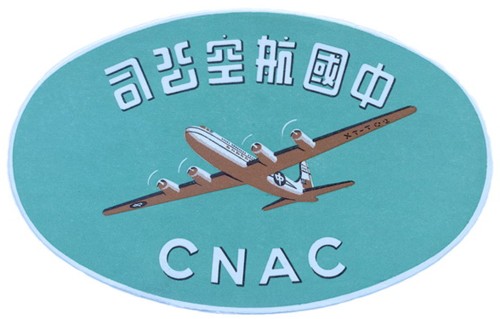 The San Francisco Airport Museums Oral History Program was initiated in 1997 to preserve first person accounts of the development of aviation. Transcribed oral history interviews are placed in the San Francisco Airport Commission Aviation Library and Louis A. Turpen Aviation Museum where they are catalogued and made available for use by scholars, historians, and the public. The Oral History Program serves to increase awareness of historic achievements in aviation by documenting this legacy for the benefit of current and future generations. For its 2003 annual giving, the San Francisco Aeronautical Society began underwriting the San Francisco Airport Museums Oral History Program. The following edited excerpts are from oral history interviews conducted with Capt. Moon F. Chin between February 2nd and March 5th of 2004 by Mauree Jane Perry of Making History Associates. The full transcript will be available to the public at the San Francisco Airport Commission Aviation Library and Louis A. Turpen Aviation Museum. Capt. Chin began his flying career with China National Aviation Corporation (CNAC) in 1933 as a copilot on the Shanghai Peking route. He became a captain in 1936 and flew transport missions before and during WW II that included flights over the Himalayas a region known as the Hump. He joined the Central Air Transport Corporation (CATC) in 1946 as head of operations where he acquired aircraft, hired and trained flight crews, and initiated operations on Mainland China. CATC became part of Civil Air Transport (CAT) of Taiwan in 1947. In 1964, Capt. Chin founded Foshing Airlines with service from Taipei to Taitung. 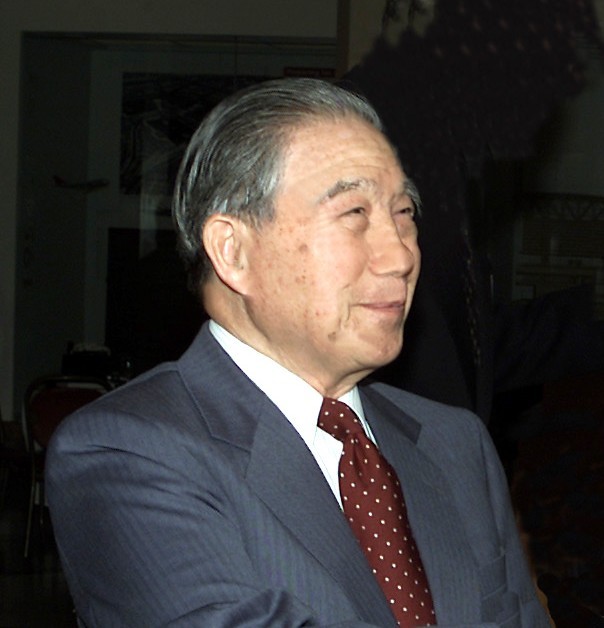 Moon F. Chin - Spring 2004 Photograph by Gabriel Branbury Mauree Jane Perry: How soon after you started working for CNAC did you begin flying the actual Shanghai Peking flight? Capt. Moon F. Chin: Well I applied for the job in January 1933, and I joined March 1, 1933. I think I waited two months. I had to start work as a mechanic since I had experience as a mechanic. So from the first of March until the middle of the month when we started flying to Peking, I worked everyday on the airplanes as a mechanic. Even after I started flying to Peking and back, I still had to work as a mechanic until I was transferred from land planes to seaplanes. Q. What navigational tools did you use in 1933? A. We didn t have any. (Laughing) No navigation no instrument flying. In fact, in those days we didn t have autogyro, we didn t have directional gyro. Later I learned by myself what we called one two three. You only look at three instruments: the air speed, the climb indicator, the bank and turn you know the ball and the needle. That s all we needed. We had oil pressure and gasoline, but those had to do with the engine. I m talking about flying. We had a compass, of course, the bank and turn, and the air speed. So you watch the three instruments. You start with the air speed. Then you go to climb indicator, then you go to the bank and turn. (Laughing) So you keep going around. See, what I learned mostly on instrument flying was when I flew from Chengtu [now Chengdu] to Chungking [now Chongqing]. I became a captain in 1936. Every chance I had I tried to fly one two three. We called it that because you looked at one instrument going round so you keep the air speed, the climb indicator, and the bank and turn and once in a while you look at compass to see the direction you re going in. Q. So after you became a captain in 1936, where did you fly? A. I flew everyday between Chengtu and Chungking. In the morning I would take off from Chengtu to Chungking and then on to Hankow [now Hankou]. After the Hankow plane came in with the Loening the next day, I would carry those passengers back to Chengtu. The DC-2 used to fly from Shanghai to Hankow to Chungking to Chengtu. That s what I did for one year. Then, around 1938, I was sent to Shanghai. They gave me two weeks leave to go to Hong Kong. When we returned after one week, that s when the trouble started in Shanghai. Then I left for Nanking [now Nanjing] and never went back to Shanghai until 1945. So after Shanghai was bombed [in 1938] I went back to my old route. Only sometimes I would fly to Rangoon or wherever they wanted. Sometimes to Hanoi. Sometimes I would fly to Guilin on that peculiar plane, the Dolphin, a stagger wing Beechcraft, a British twin-engine plane. This place was very hard to go to all mountains, and the weather was very bad. Q. So you would wake up in the morning and not know where they were going to send you to fly that day? A. When I used to fly, before Pearl Harbor, I was based in Chungking. When the planes came in from Hong Kong, I would either go with them as a copilot or I would take the plane back from Rangoon or Hanoi. Then the pilot would take them back to Hong Kong. Q. When did you start flying to Hong Kong? A. Oh, that s after Hankow was lost in 1938. Before Hankow was lost, I was stationed in Chungking I was just flying a seaplane from Chungking to Hankow. Q. You liked your work? You were flying as a copilot or pilot. You went all over southeastern China, Burma [now Myanmar], Hong Kong, Indochina [now Myanmar, Thailand, Laos, Cambodia, Vietnam, and West Malaysia]. You had different routes, different airplanes to fly. You were paid. You were married. Were you in danger? A. I liked my work. I didn t feel I was in danger. Q. What about navigation tools. How had they changed? A. You see, before I was transferred and I was in Chungking, I was more or less not alone but I did most of the work for the Chinese Air Force. In the old days, between Chungking and Chengtu, I would fly to the northwest border with Russia. I would take the pilots or mechanic to get the Russian fighters. They didn t have radio, so they depended on us to lead them- like a bird following the goose. We had the radio, and we had the Telefunken directional finder. The fighter planes range was very short. So we would lead them to this airfield. I circled until the first squadron refueled. Then, when they were ready to take off, the second squadron would go down and refuel. If there was an air raid, then I would just wiggle my wings and make a circle and go towards Chengtu. At the same time, there would be a signal on the field that an air raid was going on. They couldn t land until the refueled planes were coming up. One time I was supposed to lead a bunch of Russian bombers with Chinese pilots to Guilin. They asked me to go to Chengtu and pick up some drop-able tanks, made of bamboo. They put them under their wings to get longer range. When they finished using that gas, they just dropped them because they didn t have use for it anymore. Because they didn t have metal, they made the extra gas tanks out of bamboo. Q. Let s talk about some of the various planes you flew. A. The first plane I flew for CNAC was the Stinson. It was the biggest plane I had flown at that time. Five passengers plus the pilot and copilot. It was a high wing. Before they had the smaller tires, later they had the balloon tires because they could land on paved field where you have soft mud and things like that. It moved better than the regular tire. And then the next plane I flew was the seaplane, an amphibian Loening that flew from Shanghai along the Yangtze River. Q. Was it difficult to learn to fly a seaplane? A. No. The flying is all the same except when it lands in the water. In a seaplane you pull back on the controls to get the plane on the step, they call it. In a land plane you can drive forward to get the tail up. But in a seaplane, you have to get up on the step and once you are on the step, then you fly it like a regular plane. Q. Did you have a preference? A. Not exactly, but before you got on a seaplane you learned how to sail a boat. That was part of the training, because when you are on the water you have to learn about the wind and the current. On the Yangtze River you have downward flow. So they gave us a little sailboat, and we learned how to go downwind, crosswind so that when you get on the seaplane, it is the same thing as on a sailboat. If the wind is stronger against the current, you go into the wind. But if there is no wind, then you go downstream with the flow of the water. If the wind is strong enough and with the water, then you go against the current and into the wind. You practiced in the little sailboat on the river. The only time you have current like that is only when it is high tide or low tide. So when it's low tide, maybe you go against the wind, so you have to practice different times of the day. It s very good. When you have the engine off, you are drifting against the current. If the engine is dead and you have no power, you have to find a way to get the plane to drift so you get onto a corner where you beach the plane. You drift awhile and later on you get going. Later on they added a little rudder in the water, and then we had a cable. As a copilot the only thing you had in terms of training was when the pilot was taxiing. You had to lie on your belly on the lower wing and when he approached the floating drum you had to grab that rope and tie it on to the side of the hull, and he would cut the engine when you signaled that you got it fastened. Sometimes he would go too fast, and you couldn t hold on to it to get the rope wrapped around. So he wouldn t cut off the engine until he was sure that you had the engine tied. Being a copilot in the wintertime was terrible because it was so cold. Lying down on your belly, you d get all wet. Afterward you got up with the wind blowing and the propeller blasting; you know, you could feel your hands getting frozen. Q. How many captains were there at CNAC in 1938? A.Not many. About four American and four Chinese captains. C. L. Sharp was No. 1. Then there was Woody and Pottschmidt. At that time I was flying the seaplane between Hankow and Chungking. They were flying the land planes. So we would meet each other during different times. Two of us flew the Commodore. Sometimes we flew the Douglas Dolphin. Q. You liked the Dolphin? It had 8 seats and flew 140 miles per hour, and had a range of 720 miles. A. That was much better than the Commodore. That only went 110 miles per hour. Maybe less. We used to say it took off, landed, and cruised at the same speed. (Laughing) The Dolphin was a good plane to fly. But I remember that every time we landed I had to walk down the top of the wing spar and push the nail back in. The wing wasn t metal; it was plywood covered, no fabric. It was glued, of course, to the metal frame and rib. After so long, the wing would start flapping. So after we landed, when we would go up on the wing to gas the plane, we d walk down the spar to push the nail back in. Actually, the nail was not doing any good. It was the glue holding it together. Q. So you were based in Chungking during the war. The question is why were you even flying all the way to the Russian border? A. Because we flew to Yining. That s where the Russians brought the planes over to China. In 1937 38 the Russians flew the planes themselves. But later on, they didn t have the pilots. They just sold the planes to the Chinese. They didn t fly over. The Japanese were protesting over this. So the planes would come from Moscow and would land over on the Russian side. Then they would pull them by hand over the Chinese border and they would tow them down to the airfield here. The airfield is closer to the border actually. I remember when I flew there the town was not much. Yining is the Chinese airfield on this side, and this is the Russian airfield on the other side. Alma Ata is the Russian base. SAS used to fly in and out of and stop there on the way to Scandinavia. Anyway, before we used to go from Chengtu. Lanchow [now Lanzhou] and Chengtu and Chungking. The Chinese Air Force was in Chengtu. Chungking was the wartime capital. Xi'an is here. This is the area where they tested the atomic bomb. This is the end of the Great Wall, the end of the Himalayas that goes all the way to the Great Wall. Hami is here. Turpan is the second lowest place in the world. Below sea level. But the mountains here are over 15,000 or 16,000 feet. Q. Had these western routes [across the Northwest Frontier] you flew ever been flown before? A. No, never before. Q. So how did you know where the mountains were and how high they were? When you chart a path in such difficult territory, how do you go about it? A. First he [C. L. Sharp] gave me the report. They took off from Peshawar, the northwest frontier of India at that time. He described this area. He was already flying around 30,000. The B-24 can go up that high. But we could only go around 20,000 feet. After he couldn t see Yarkant, he said he followed the Yarkant River. There were sandstorms. This area is all desert. Q. What is it that you did that the B-24 couldn t do? A. They started from India, trying to survey, and they couldn t see so they turned back. Q. I see because of the dust storms and because they were so high up in a B-24. But you were in a DC-3 and could stay under the clouds? When you chart a path, what do you do? A. We studied where the path was so we could get through. There are three paths we could get through. We only looked at the one path, but we could see the other side, and we went through it. If we couldn t see the other side, we didn t go through. (Laughing) There is another pass near Afghanistan. After Afghanistan there is Russia, so there are four countries that touch. So, in the summer of 1942 we went south to New Delhi, then to Karachi, then to the northwest frontier near Peshawar, what they called in the old days, the Northwest Frontier. It had many troubles before in the old days. Then we spent the night there. The Air Force gave us dinner. They all wore gloves, the British. (Laughing) Q. Where did you get your gas supplies? A. We still had the U.S. Army with the star and the two bars indicating it was an American plane. When we left Calcutta we got gas. We got gas at Kunming, that s where the Chinese Air Force was. But when we went there, they didn t have the high octane. Q. I wanted to ask you where you were when Pearl Harbor occurred? A. I was in Hong Kong. Pearl Harbor was on December 7. But in Hong Kong it was the nighttime on the 8th. On the morning of the 8th I was still in bed. I saw a formation of fighter planes start coming down. I thought they were practicing. From my bed I could see the Pan American Clipper in the water. I saw the tail of the DC-2 in front of the hangar. All of a sudden I saw water spraying up. They were machine-gunning that Clipper. But the Clipper had been waiting to go to Manila, so it had a lot of gas in its tank, and it caught fire right away. I don t know if they actually dropped a bomb on the Clipper or not, I didn t see. But I saw the DC-2 s tail start to burn, and I saw the Clipper burn first. After it was over, I drove my car to the market to buy some rice. I saw the DC-2 burn up. Then when I got home, I got a telephone call to prepare to leave that night. The company called me. Get ready to leave tonight? I said, But all the planes burned up. He said, No, one plane didn t get hit. We pushed it off the airfield. And the two planes didn t come back last night. So we still had three airplanes, you see. Q. So now let s talk about the Doolittle experience. After Pearl Harbor, Jimmy Doolittle and his sixteen U.S. Army B-25 bombers broke through Japanese defenses on April 18, 1942, to strike Tokyo and other cities in broad daylight. It was a daring and dramatic raid. Then he flew on to China. A. On my regular flight out of Chungking, we were delayed, and we didn t know what the reason was. We saw the American ambassador and all hanging around. When the party came down and they all got near the cabin door, we were sitting in the cockpit. I was the pilot. But I didn t see who was coming. It was April 1942. Then they got around the entrance door to the plane, and then I saw people climb up on the plane and the others got away. They cleared us to start the engine, and we took off for Kunming. Less than an hour before we got to Kunming, we got a warning that there was an air raid going on. So we found an airstrip in the mountains and we landed there. We landed on this place and we got everybody out of the plane and we hid in a ditch. We had a crew of four, and then of course about eight or ten passengers. Doolittle was one of them. The others were regular passengers. And when I got down, he came next to me and I saw his name, Doolittle. First I saw his clothes were pretty dirty. When he came over to me in the ditch, I told him I remembered him back in 1933 in Shanghai. Then when we got clearance, I got all the passengers on the plane, but he didn t get on the plane. He just stood there near the wing tip talking to me. He said, Which way are you going to take off? This airfield was not level, it was uphill, and we were parked in a down part of the hill. I told him I was going to take off downwind. Usually a plane takes off upwind. Then he said, O.K. If you were going to take off upwind, then I was going to stay here. (Laughing) Then of course there was some telephone wire on a bamboo pole in a ditch or something. Only a couple of telephone wires. So he said, What about those? I said, Gee, if we don t make it we ll just take the wire with us. (Laughing) He got on the plane. Then when we landed in Kunming, General Chennault was waiting. They saluted each other and drove away. So when it was time to leave, they came in and got in the plane. We were supposed to go to Dinjan. That s what he thought. But the instruction was to get to Myitkyina, which is in the northern part of Burma. We were supposed to pick up the radio operator and the company personnel and equipment because that was the last day they were going to be there. Q. Did you know what was happening politically in Myitkyina, that is, that it was under attack? A. Yes we knew that because we were supposed to pick up the company personnel. Q. Were you frightened? A. Oh no. (Laughing) When we were flying we should have been flying northward, and Doolittle wrote me a little note on a piece of paper, and he gave it to the radio operator. The operator no first he asked the radio operator, Why are we flying north? The operator told him because we were going to Myitkyina. Then he wrote on a piece of paper that the ambassador in Chungking told him Myitkyina had fallen that afternoon. I told the operator, no, the company would have warned me not to go to Myitkyina if it had already fallen. I didn t pay any attention to him. Then when we got to within twenty-some odd miles of Myitkyina, I saw a plane up in the air on the way to Dinjan. It looked like the last plane. I couldn t see what plane it was, but it looked like it was on. Then when we got to within twenty-some odd miles of Myitkyina, I saw a plane up in the air on the way to Dinjan. It looked like the last plane. I couldn t see what plane it was, but it looked like it was on its way to Dinjan. Then we got to Myitkyina. We saw all the people leaving the airfield. That was the last plane. So they all left. A big crowd. They were trying to get out on that plane. When they saw us approaching they all returned, rushing back to the airfield because they thought another plane was coming in for them. So when we landed, we found out that all the people we were supposed to pick up had gone on that last plane the radio equipment and all the personnel, because we were late. Because of the air raid we were delayed a couple hours. So the radio operator didn t know what we were doing. See, before we got to the airfield, he had disassembled his radio equipment so he didn t know what was going on. Then all the refugees wanted to get on the plane. We started loading them. Q. Whose decision was it to load the refugees on the plane? A. Well, they all crowded around. They all wanted to go. We tried to take as many as we could. Q. So it was your decision? A. Yes, well, actually Doolittle helped. We had to take the ladder away because we didn t want people climbing up. We picked the older people and the ladies with the kids. In fact, we had a lady get on board but her husband couldn t get on board so she jumped back out. He looked very healthy, see. So she jumped back out. When we were nearly packed, Doolittle wanted to know what the hell I was doing. I said, We do that quite often. After we were all full, we closed the door. Then we got everybody out of the way so we could taxi and take off. I figured that since we had a full load, we shouldn t go to Dinjan, so we went direct to Calcutta. We just had enough fuel to reach Calcutta. Q. And this plane that usually held only twenty-one people held how many? A. Seventy, I think. Just packed in there. Sitting on the floor. Standing up. Then we landed. We found when we opened the cargo door we had another eight people packed in the cargo area. When we landed in Calcutta, the American embassy people came. Doolittle disappeared. He didn t go through customs. He didn t go through immigration. I didn t know what was what. Then the next morning I looked at the paper and read that he had bombed Tokyo. Q. You hadn t known that he had bombed Tokyo? Q. You land and you see all the refugees climb out of the plane. You see the extra people climb out of the cargo, and then you saw that Doolittle didn t have to go through customs. Did you say goodbye to him. Did he say goodbye to you or give you a thumb s up? A. No, he waved. I saw him talking to the people meeting him, people from the consulate. When I read the papers the next day, I said to myself, he went to all that trouble, and then I almost got him killed. We talked to each other a couple times, before the war ended and after the war. We just said hello to each other. Q. If you had known you were carrying this important man, would you have done anything differently? A. I wouldn t have gone to Myitkyina. Q. But you know the airline, the company, must have known you were carrying Captain Doolittle? A. They knew he was on board, but they didn t know he had bombed Tokyo. Nobody did. See the news didn t come out until after he left Calcutta. Q. What did you do for oxygen if you were flying up to 15,000 feet? A. In early days we only had portable oxygen. Later the planes had the low-pressure oxygen system in the aircraft. But we didn t use it until 8,000 feet. Usually we didn t use it until 10,000 feet. In 1943 I came to the United States, and I flew the DC-4. I was checked out at American Airlines at La Guardia Airport. I liked this airplane. In those days it was a big airplane. (Laughing) Of course, any time you have a big airplane like that there were more things to handle. But it was very easy, for every Douglas airplane was almost the same. Then at the end of 1943 44, we had the C-46 Commando. It could go about 1,400 or 1,500 miles. Q. Where did you fly this transport plane? A. During the war, CNAC got delivered one or two a month. We started getting it the end of 1943. When I flew for CATC, we bought nine of those from the Foreign Liquidation Com-mission. It was like surplus, planes that were left in Shanghai. Then the C-47s, I bought two of those in 1946. They were brand new. Never been flown, just shipped to India. I bought them for $5,000 apiece. I bought them for CATC. The company bought them. I bought two of them for training. I used them mostly flying between Shanghai and Nanking when they asked me to go to a meeting. These were trainers, not for passengers. We needed them for training, since we were starting a new company. Q. Why did you use this particular plane to train pilots for the new company? A. For basic training. At that time after the war, we figured we had to train from the ground up. Of course, CATC bought six of the Convairs. It was the first new plane after the war. The DC-6 came out right after that. I was checked out on that in 1949. Q.Who checked you out? A.We had sent twelve crew over here to train with American Airlines in Ardmore, Oklahoma. Then, when they ferried the planes back, I flew back and forth with them on the trips. Originally when we purchased these planes, they were from Shanghai. But when we got the planes, Shanghai was almost gone, so we used the planes between Hong Kong, Taiwan, and Bangkok. Two of the planes arrived, and they didn t make a single trip because there was no place for them to go. _________________________ Photograph by Gabriel Branbury. CNAC luggage label, 1940s, San Francisco Airport Museums, gift of the Pan Am Association. Published as a supplement to the Spring 2004 issue of FAM 14, the newsletter of the San Francisco Aeronautical Society. Copyright 2004 San Francisco Aeronautical Society. All rights reserved. Contact SFAS@sfoArts.org for San Francisco Aeronautical Society membership information. The book should be published around Christmas of this year, 2007. 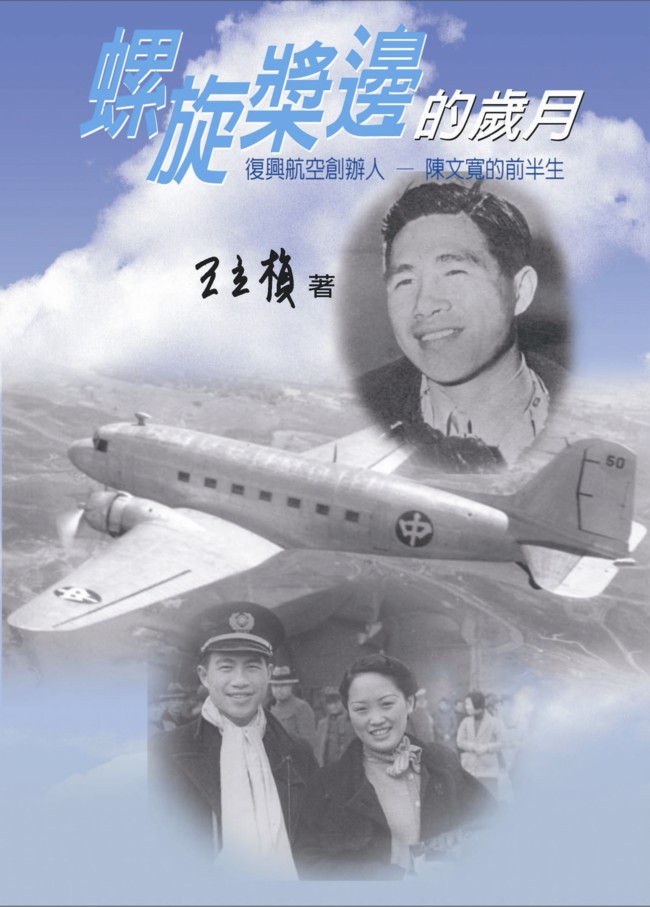 The following three links will show a three page article written by Liu Xiao Tong of Chengdu, China, about Moon F. Chin. Page one Page two Page three Liu Xiao Tong has written these two books: 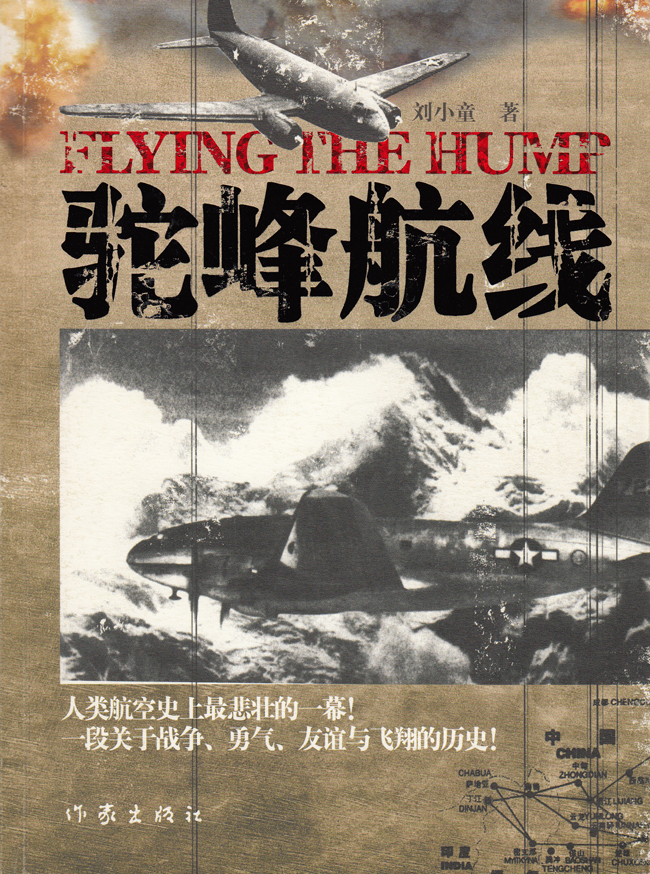 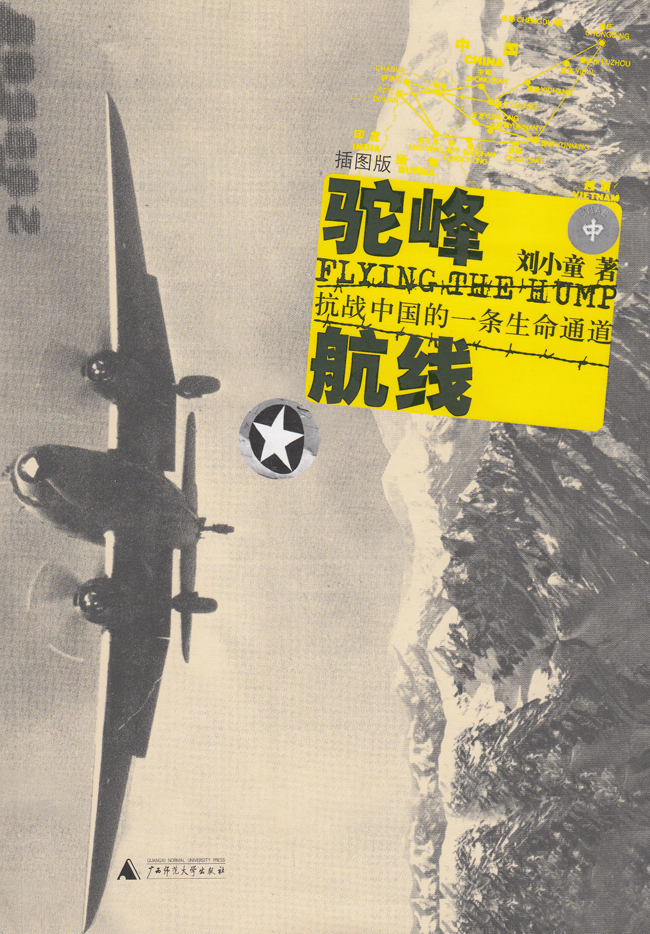  or would like to be added to the CNAC e-mail distribution list, please let the CNAC Web Editor, Tom Moore, know. Thanks! |